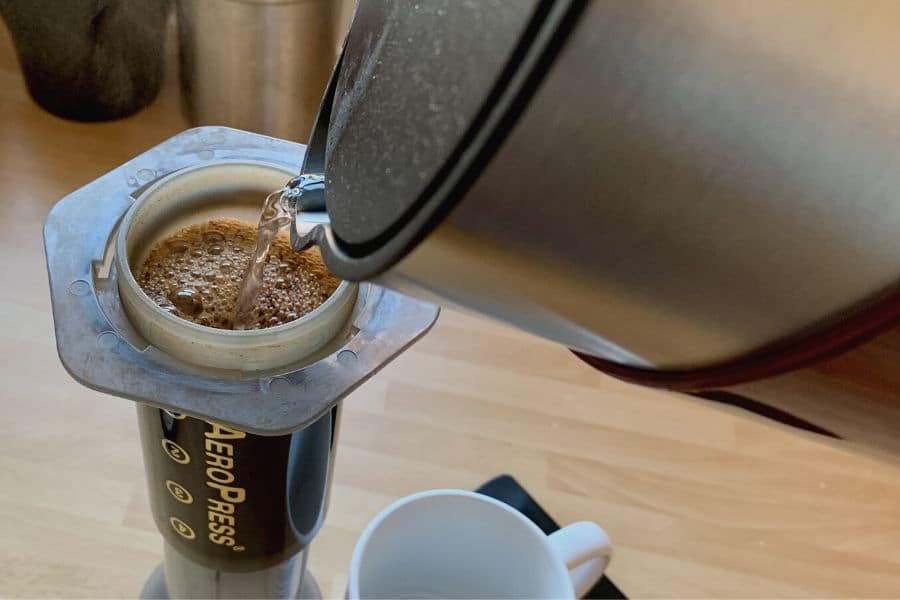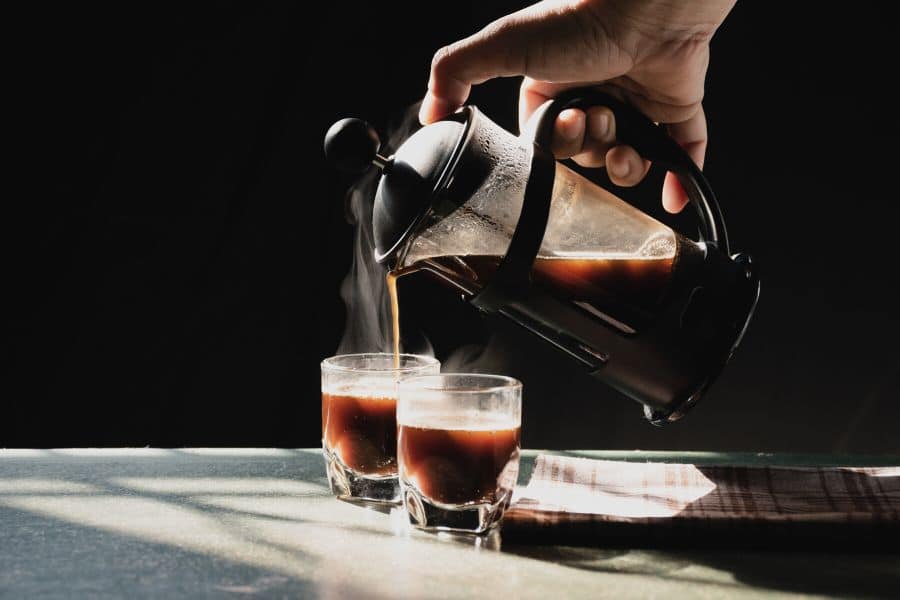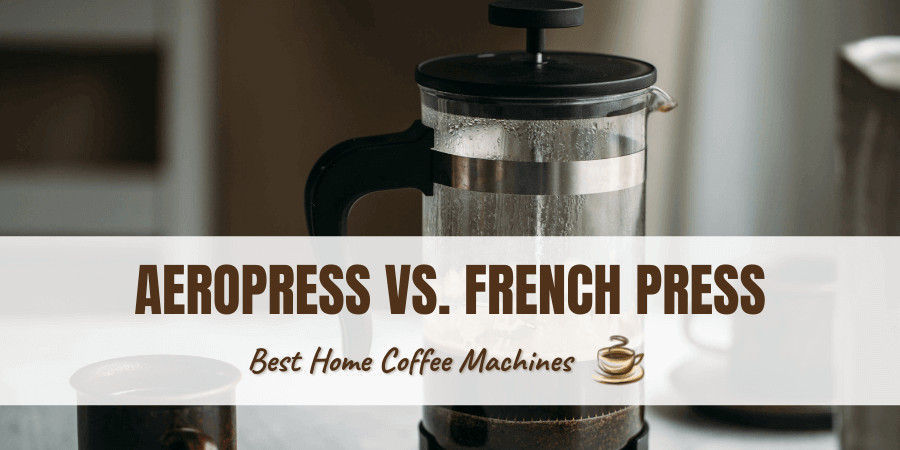French Roast vs. Italian Roast
Although their names imply they’re related in the coffee world, comparing AeroPress vs. French press isn’t entirely clear-cut. There are several differences between these two brewing methods, hence the coffee from one isn’t like a beverage from the other.
While AeroPress isn’t a newcomer to brewing java, it’s still a child compared to the number of years the French press has been in use. However, both are quite popular manual coffee brewers, and you’re not likely to convince a French press lover that they should try an AeroPress or vice versa.
But what if you’re trying to decide between the two? Let’s run through the perks of each and what might make one the better choice.
Some things we’ll cover for your AeroPress coffee vs. French press decision:
The Modern AeroPress
The AeroPress coffee maker debuted in 2005 as a total immersion brewing system — promising brewed coffee in around 2 minutes. This device is lightweight and small, and typically made from BPA-free plastic. Because it’s so compact, it’s easy to pack up and take wherever you’re going.
No electricity is required with an AeroPress, but you will need heated water. It consists of two plastic cylinders, with a plunger and also uses paper filters that prevent coffee grounds from slipping into your cup of joe. The AeroPress relies on air pressure to force coffee through a paper filter into your mug.
For more specifics with step-by-step instructions, read our how to use an AeroPress coffee maker guide.
It takes approximately 2 minutes to brew about 8 ounces of coffee that resembles espresso. While this java is great on its own, it can also be used as a starting point for lattes or cappuccinos. The AeroPress works with either ground coffee or ground espresso, and a medium-fine grind level, similar to grains of sand, works best. You can even use fine or espresso grind levels.

Advantages of the AeroPress
While some coffee purists may scoff at the idea of brewing java in a small plastic device, the AeroPress does offer several advantages over other brewing methods.
- Not solely for brewing simple coffee, the AeroPress can also be used to create lattes and cappuccinos.
- Makes flavorful java that isn’t bitter or acidic.
- Paper filters trap grit, giving your coffee a clean flavor.
- Cleanup is simple, just rinse all parts.
- Its compact size makes it super portable and ideal for a cup of Joe on the go.
Disadvantages of the AeroPress
This innovative device also has a few drawbacks that should be mentioned.
- It can be messy. There’s a little trial and error involved in learning to position it correctly over your cup.
- There’s a learning curve for newbies to AeroPress. As it only makes about 8 ounces of coffee, it’s not as forgiving if your coffee/water ratio isn’t correct, or if you’re not using the proper grind level.
- It can’t be used for cold brew coffee. We don’t always want hot java!
- If you want more than one regular-size cup of java, you’ll have to brew all over again. As mentioned, you’re limited to 6-8 ounces.
The Traditional French Press
Like an AeroPress, a French press is also an immersion brewer. It was reportedly invented in the late 1800s, but wasn’t patented until the 1920s, and remains a popular method of brewing coffee. This device works best with coarse coffee ground right before brewing.
A French press includes a carafe, metal mesh filter, and plunger assembly. It’s a manual coffee maker, so no electricity is needed, although you will need some way to heat water. Brewing takes approximately 3-5 minutes, depending on how long you let the coffee steep before pushing its plunger down.
Most commonly, the French press is made of glass or heat-resistant plastic, but some are crafted from stainless steel. This device works by allowing coffee to steep in very hot water for a short time, and then pushing the plunger down to trap grounds at the bottom. After that, pour the coffee into your cup, while most grounds remain trapped by the plunger.
For more detailed instructions, check out our step-by-step guide on how to make coffee with a french press like a pro.

Advantages of the French Press
Coffee lovers who adore the French press won’t hesitate to rattle off the reasons you should use one. But they’re not wrong. There are many fab aspects of a French press.
- It’s easy to brew java with it. The steps are pretty simple, and a French press is a little more forgiving if you don’t get the proportions exactly right.
- Rich, heavy coffee is what this device excels at brewing. One reason for this is that more oils from coffee beans make it into your cup of java.
- Can be used to make concentrate for cold brew.
- Available in various sizes. French press coffee makers range in size from about 6 ounces to over 30 ounces.
Disadvantages of the French Press
Even though a French press has lots of pluses to smile about, it has a few downsides.
- It takes a few more minutes for your morning java. Compared to an AeroPress, French press coffee requires a bit more brewing time.
- Cleaning is more difficult. There are more nooks and crannies with this coffee maker, plus it’s recommended to hand wash with dish soap.
- Depending on what it’s made from, a French press is generally more delicate than other coffee makers. Many are made from glass, so as we all know, it’s not easy to just pick up and go with something that fragile. If you’re looking for something portable, a glass French press isn’t it.
- Due to the lack of paper filters, French press coffee is considered unfiltered — which research suggests is linked to a greater risk of high cholesterol.
AeroPress or French Press — Which One Is Better?
Truthfully, there’s no outright winner in this French press vs. AeroPress competition. A French press makes delicious java. An AeroPress also creates awesome coffee. You’re not going to go wrong with either one.
However, one substantial difference between AeroPress and French press is the beverages they produce. This is why some people favor one over the other. AeroPress coffee has a reputation for being smooth, full of flavor, and free from grit or sediment. A French press will brew rich, strong coffee that includes some oils from coffee beans — along with some grit in your cup.
A French press is a solid choice for someone only brewing java in their kitchen — most are too fragile to make them portable. An AeroPress can also be perfect for home brewing, but as it’s small and compact, you can swiftly pack it up for camping or travel.

Final Thoughts
Regardless of whether you prefer the traditional method for making coffee or a modern twist, you’ll be able to brew some amazing java. A coffee bean grinder will be needed with either a French press or an AeroPress — it’s always best to use freshly ground coffee.
However, when you weigh up the AeroPress vs. French press price tags, both are clearly within reach of anyone — from coffee newcomers to seasoned java drinkers. Why not skip the decision-making and buy both!
AeroPress or French Press FAQs
Is AeroPress Similar to French Press?
There are some similarities between the AeroPress and the French press. They’re both full immersion brewers, which means that ground coffee is steeped in water for a short time period. They’re also both manual coffee makers, so hot water aside, no electricity is required. However, the AeroPress creates java that tastes cleaner without bitterness, while French press coffee is richer and grittier.
Does AeroPress Make Better Coffee?
The AeroPress brews some really decent java, but taste can be subjective. If you prefer no grit or sediment in your cup of joe, with a somewhat more mellow flavor, then you should definitely give AeroPress coffee a try.
What’s the Difference Between Espresso and AeroPress?
The main difference is the level of pressure generated during brewing.
An AeroPress creates less than one bar of pressure, while to brew true espresso, you need at least 9 bars. However, AeroPress coffee, much like espresso in its richness and flavor, can be used as a starting point for lattes or cappuccinos.
Is French Press Coffee Bad for You?
There are a few health concerns with French press coffee, since it’s considered to be unfiltered. Studies have shown that drinking unfiltered java can raise LDL cholesterol, also known as bad cholesterol. This is thought to be because of oil from the coffee beans passing into the brewed beverage. That oil is also something that some French press fans love about this brewing method.
Does Coffee Taste Better in a French Press?
Lots of people love French press coffee. The extracted flavors make for some rich, strong, delicious java. Some prefer the mouthfeel of this beverage, as it includes some oil and grit from the coffee beans.
What Grind Is Best for AeroPress Coffee?
A medium-fine, fine, or espresso grind is recommended for an AeroPress. These grind levels provide more surface area of the coffee for extracting flavors. However, if your grind level is too fine, you may find it harder to press down on the AeroPress to make coffee.





